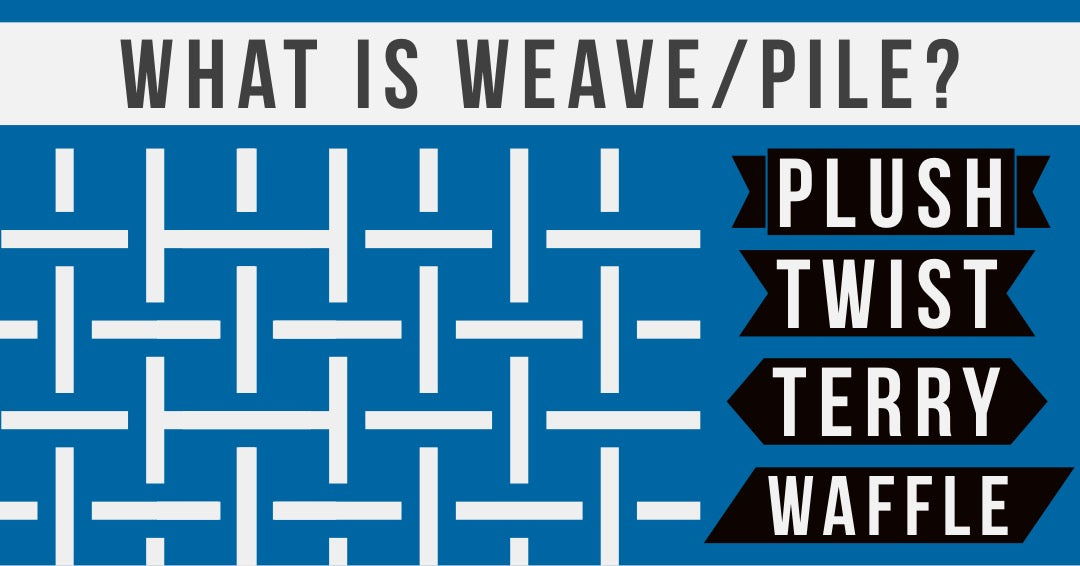
What is Pile or Weave? About Microfiber Types
The weave, or pile, of a fabric describes how the yarn on the surface of the material is oriented. It describes the shape or tuft of the yarn fibers. It is determined by the type of knitting or weaving machine that the fabric is made on.
These characteristics are separate from weight (gsm) and blend.
Different types of microfiber towel material can have different pile lengths:
- Low
- Medium
- High (Plush)
The pile weave structure can also other characteristics, like:
- Pattern/Shape
- Softness/Roughness
Examples of different types of Pile/Weave:
Terry

The fibers are open ended and are bundled in small groups. The millions of open ended fibers have great all-purpose cleaning ability.
Terry microfiber is the most common and versatile type available. It is the weave most associated with the word “microfiber”. It is characterized by a medium to low pile, with the same size nap on each side. It is cost effective, absorbent, collects dirt and dust, is low lint and not likely to lint.
It is available in a GSM range from 200gsm to 400gsm.
Examples:
Plush

Plush fabric has a high pile on both sides of the material. It is usually soft and gentile, and is ideal for cleaning delicate surfaces, like soft paint.
The long fibers add cushion between the towel and surface and minimize surface area contact.
The long pile reduces the pressure that is applied to the surface.
For some cleaning tasks, the long, soft fibers are not aggressive enough to clean effectively.
DOWNSIDES: The fibers can create friction and extra drag when wet. The long fibers can be broken on rough surfaces and can shed lint, when used with some chemicals.
Some plush towels are actually two separate sheets of one-sided microfiber laminated together, back to back.
Plush fabric types range from 350 to 1200 gsm.
Examples:
Two-Pile

Two pile towels have one side with a high pile and the opposite side with a low pile.
These towels are popular because of their versatility. The high pile side is good for Quick Detail Spray, Spray Wax, Compound & Polish removal. The low pile side is good for glass and cutting through tough compound or polish residue.
Many detailers prefer this type of towel for coating wiping and leveling. The low pile side can be used for the initial wipe and the high pile side for the secondary wipe.
Examples:
Pearly

Pearly weave towels have a tight weave with a low (closed loop) pile.
While still soft, like higher pile towels, and are more aggressive than their plush counterparts.
They are great for compound and polish wiping, paste wax residue removal, and coating leveling.
The low pile, and tight weave make them especially functional glass towels.
Examples:
Waffle Weave

Waffle-weave towels have no pile, but instead have a cross hatched pattern of high and low spots (like a waffle, hence the name).
The waffle pattern reduces the overall surface contact of the material, making it glide over the surface with less friction. The waffle ridges create sections of fibers with a more vertical angle of attack and swipe up water like thousands of windshield wipers.
These towels are the original microfiber car drying towels. The reduced friction and fast absorbency make them particularly well suited for glass cleaning.
Examples:
Twist

Twist Pile Microfiber is characterized by long loops of fiber bundles twisted in a double helix pattern.
The twist piles drastically increase the surface area of the yarn that can be exposed to the surface being wiped. The tight bundles of fibers reduce friction making wiping easier.
This material is a modified version (made softer and less aggressive) of microfiber designed for wet floor mopping. The physical structure of the twisted fiber bundles allows the material to glide over the surface with ease, whereas the plush microfiber creates more drag when wet.
The high absorbency and reduced friction make these towels particularly well suited for drying and glass cleaning.
Examples:
Chenille

Chenille microfiber is characterized by thick bundles of microfiber “fingers” which stick through a thin base layer of fabric. The long cylindrical shaped bundles have a high surface area, and are spaced to allow them to easily move from side to side, as they clean.
This material is well suited to work wet, and is often used to make car wash mitts, sponges and pads.
Examples:
Suede

Suede microfiber has an extremely low pile with a smooth and soft feel. It is very similar to the non-cleaning microfiber you will find in clothing or furniture.
The minimum pile and soft feel, is lint free, make it a great material for lens, screen and monitor cleaning. It is highly efficient for wiping away smudges and finger prints.
Many detailers prefer to use suede for the application of ceramic coatings.
Examples:
Diamond

The Diamond Weave is a modified version of our original no-pile smooth glass towels. The diamond pattern reduces overall surface contact of the material and reduces drag making wiping faster and easier.
These towels are best for hard non-delicate surfaces like glass, metal and chrome.
Examples:
Mesh

Mesh microfiber material is great for scrubbing tasks like upholstery and leather cleaning and removing dead bug residue.
The web-like pattern has small holes and openings that allow the fabric to work at a high angle against the surface being cleaned. The thin openings work like hundreds of mini razor blades mechanically cutting caked-on, sticky, and stubborn debris.
Examples:
In Conclusion...
As you can see there are a lot of different types of microfiber pile and weave! Even though they can be made with the same base fibers and yarn, the physical construction of the fabric has different mechanical cleaning properties, making the different types better for different detailing tasks.


Leave a comment